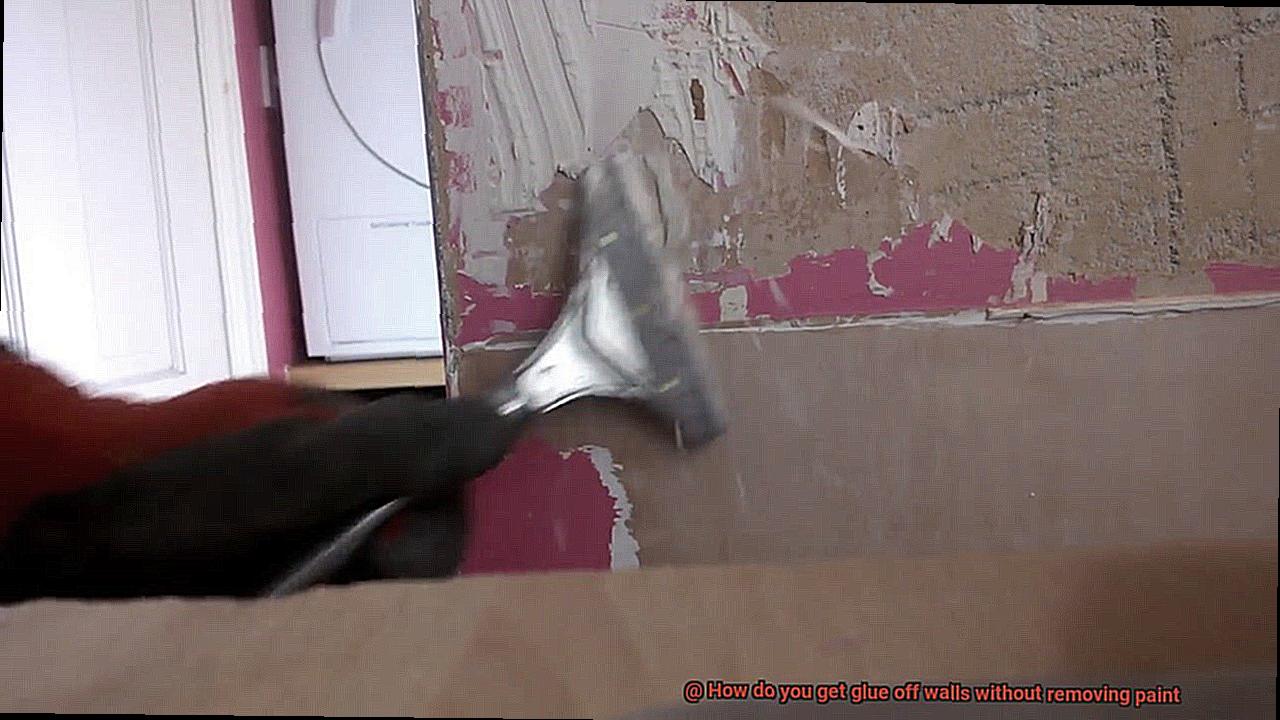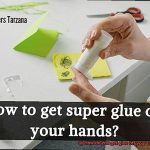Picture this: you’re gazing at your freshly painted walls, basking in their pristine beauty, when suddenly, you spot it. An annoying blob of glue sticking out like a sore thumb. Ugh. But fear not, my friend. We’ve got your back with our ultimate guide on banishing glue from walls without causing any paint casualties.
From arts and crafts mishaps to stubborn tape residue, we’ve got solutions for all types of sticky situations. Say goodbye to those pesky dried glue stains that haunt your walls. With our expert tips, nifty household remedies, and foolproof techniques, you’ll have those walls looking brand-spankin’ new in no time.
So buckle up and get ready to bid farewell to the ghostly remnants of glue that dare to mar your wall’s flawless facade. Let’s dive into this sticky adventure together and reclaim the glory of your walls without a single paint flake being harmed along the way.
What is Glue?
Contents
- 1 What is Glue?
- 2 How to Remove Glue from Walls without Removing Paint
- 3 a. Heat Gun or Blow Dryer Method
- 4 b. Solvent or Adhesive Remover Method
- 5 c. Household Items Method
- 6 d. Natural Adhesive Remover Method
- 7 When to Seek Professional Help
- 8 Tips for Removing Glue Safely and Effectively
- 9 Considerations for Different Types of Paints
- 10 Pros and Cons of Each Removal Method
- 11 Conclusion
Glue, the magical adhesive that brings materials together, is the unsung hero behind countless creations, repairs, and constructions. From the humble PVA glue to the mighty epoxy, the world of glue offers an array of options to suit every project. In this fascinating exploration, we will delve into the science and art of glue, discovering its various types and their specific applications.
Types of Glue and Their Applications:
PVA Glue:
PVA glue, also known as white glue or school glue, is a versatile adhesive that works wonders on wood, paper, fabric, and cardboard. Its flexibility and ability to dry clear make it the go-to choice for craft enthusiasts and DIYers seeking seamless results.
Epoxy Glue:
When it comes to bonding metals, ceramics, and glass with unwavering strength, epoxy glue reigns supreme. Composed of resin and hardener that are mixed just before use, this adhesive creates an unbreakable bond capable of withstanding extreme conditions.

Super Glue:
For quick fixes and instant bonding of materials like plastic, rubber, and metal, super glue is the unstoppable force. Its cyanoacrylate composition ensures an immediate bond upon contact, making it a reliable option for urgent repairs.
Hot Glue:
Enter the world of crafting with hot glue, a thermoplastic adhesive applied using a hot glue gun. This wonder substance solidifies rapidly upon cooling, making it perfect for temporary fixings, creative projects, decorations, and even floral arrangements.
Construction Adhesive:
Designed for heavy-duty applications, construction adhesive boasts unparalleled strength when bonding materials such as concrete, stone, and metal. With its resilience against extreme temperatures and unwavering durability, it serves as a staple in the construction industry.
Removing Glue Without Damaging Paint:
While glue is a lifesaver, removing it from walls without damaging the paint can be a daunting task. Fear not, for here are some effective techniques to tackle this challenge:
- Softening with Heat: Gently heat the glue with a heat gun or blow dryer to make it pliable. Then, skillfully scrape it off with a plastic scraper or credit card.
- Solvent or Adhesive Remover: Apply a specialized solvent onto a cloth or sponge and dab it onto the glue. Allow it to penetrate, and then gently rub the adhesive away.
- Household Remedies: Vinegar or rubbing alcohol can dissolve glue effectively. Soak a cloth in either substance and gently rub over the glue until it softens, then wipe it away.
- Natural Adhesive Removers: Surprisingly, peanut butter or mayonnaise can be effective in removing glue. Apply a small amount, let it sit, and then gently rub the area until the glue lifts off.
How to Remove Glue from Walls without Removing Paint
Removing glue from walls without damaging the paint can be a challenge, but fear not. With the right techniques and a little patience, you can tackle that sticky situation and restore your walls to their former glory. In this guide, we’ll walk you through five effective methods using everyday items you may already have at home. Get ready to bid farewell to glue stains.
Soften and Scrape with Heat:
Ready your hairdryer or heat gun, set it to a low setting, and hold it a few inches away from the glue. Move it back and forth to gently heat the adhesive until it becomes pliable. Now, grab a plastic scraper or credit card and slowly scrape off the softened glue. Remember, slow and steady wins the race.
Dissolve with Rubbing Alcohol:
Raid your medicine cabinet for some rubbing alcohol or isopropyl alcohol. Dampen a cloth or sponge with the alcohol and gently rub the glue until it starts to dissolve. Wipe away the residue with a clean cloth. But first, test the alcohol on an inconspicuous area of the wall to ensure it won’t harm the paint.
Vinegar and Water Magic:
Create a powerful solution by mixing equal parts white vinegar and warm water in a spray bottle. Spritz the solution onto the glue and let it sit for a few minutes to loosen the adhesive’s grip. Armed with a clean cloth or sponge, wipe away the glue, revealing a pristine wall underneath.
Trusty Commercial Adhesive Remover:
When all else fails, it’s time to bring out the heavy artillery – a commercial adhesive remover. Follow the product instructions carefully and test it on a small area of the wall first. Apply the remover to the glue using a clean cloth or sponge, allowing it to work its magic. Finally, gently scrape off the softened glue.
Repaint as a Last Resort:
In rare cases where the glue has dried for an extended period or none of the above methods work, repainting may be necessary. Start by sanding down the glue residue, then apply a primer. Finally, repaint with a color that matches your existing wall paint for a seamless finish.
a. Heat Gun or Blow Dryer Method
When it comes to removing glue from walls without damaging the paint, two popular methods stand out: the heat gun method and the blow dryer method. Both techniques involve applying heat to soften the adhesive, making it easier to scrape off. However, each method has its own advantages and disadvantages.
The heat gun method offers several benefits. Firstly, heat guns are specifically designed for applications that require high temperatures. They produce a concentrated stream of hot air, which can quickly and efficiently soften stubborn glue. Additionally, heat guns often have adjustable temperature settings, allowing you to control the level of heat applied. This is especially useful when working with delicate surfaces or materials that may be sensitive to excessive heat.
On the other hand, blow dryers are more commonly found in households and are generally less powerful compared to heat guns. While they may not reach the same high temperatures as heat guns, blow dryers can still provide sufficient heat to loosen glue. They are also more readily available and easier to use, making them a convenient option for smaller glue removal tasks.
However, there are some drawbacks to consider. Heat guns generate significantly more heat than blow dryers, which can be both an advantage and a disadvantage. While the high temperatures allow for faster and more effective glue removal, they also pose a greater risk of damaging the wall’s surface if not used with caution. Blow dryers, on the other hand, produce lower temperatures and are therefore less likely to cause damage. However, this also means that they may take longer to soften stubborn glue.
b. Solvent or Adhesive Remover Method
Removing glue from walls can be a challenging task, but the solvent or adhesive remover method offers a reliable solution. This method involves using a chemical solution to dissolve the glue, making it easier to remove without damaging the paint.
One commonly used solvent is rubbing alcohol, which is safe and readily available in most households. To use this method, dampen a cloth or sponge with rubbing alcohol and gently rub the affected area. The alcohol will dissolve the glue, allowing you to wipe it away effortlessly. However, it’s important to test the alcohol on a small area first to avoid any unwanted damage or discoloration.
Another powerful solvent is acetone, but caution is needed as it can be harsh on certain types of paint. Before using acetone, check if your paint is acetone-resistant. If not, consider alternative methods. When using acetone, apply a small amount to a cloth or sponge and gently rub the glue until it dissolves. Work in a well-ventilated area and protect your skin with gloves.
For stubborn adhesive residues, specialized adhesive removers are available. These removers are formulated to dissolve adhesives without causing damage to painted surfaces. Simply apply the liquid remover directly to the glue using a cloth or sponge, following the manufacturer’s instructions carefully.
Safety should always be a priority when using solvents or adhesive removers. Work in a well-ventilated area to avoid inhaling fumes and protect your skin with gloves. Test the solvent or adhesive remover on a small, hidden area to ensure compatibility with your paint.
c. Household Items Method
We’ve all been in a sticky situation, trying to remove glue from walls without causing any damage to the paint. But fear not. Today, I will unveil the secret to conquering this pesky problem using everyday household items that you probably already have in your pantry or bathroom cabinet. Say goodbye to unsightly glue stains and hello to pristine walls.
Vinegar: The Gentle Cleaning Agent
Vinegar is the superhero of cleaning, and it works wonders on glue stains too. Create a powerful solution by mixing equal parts vinegar and warm water in a spray bottle. Spritz the solution onto the glue and let it sit for a few minutes. Then, armed with a cloth or sponge, gently scrub away the glue. Rinse and dry the area, and voila – no more sticky residue.
Rubbing Alcohol: The Dissolver Extraordinaire
Rubbing alcohol is another household hero that can save the day. Dampen a cloth or sponge with rubbing alcohol and gently rub the glue until it starts to loosen its grip. Keep rubbing until every last trace of glue is banished from your walls. Remember to rinse and dry the area afterward.
Baking Soda: The Stubborn Stain Fighter
For those stubborn glue stains that refuse to budge, baking soda is here to save the day. Create a paste by combining baking soda with a small amount of water. Apply the paste to the stain, allowing it to sit for a few minutes. Then, armed with a damp cloth or sponge, gently scrub away at the stain until it begins to vanish. Rinse and dry the area, bidding farewell to that unyielding glue.
Dish Soap, Baby Oil, or Peanut Butter: The Surprising Allies
Try using dish soap, baby oil, or even peanut butter to bid adieu to glue stains on your walls. Apply a small amount of your chosen household item to the glue stain, let it work its magic for a few minutes, then gently scrub with a cloth or sponge. Rinse and dry the area, relishing in the satisfaction of a glue-free wall.
d. Natural Adhesive Remover Method

I am here to unveil the ultimate secret to defeating those adhesive stains: natural adhesive removers. These miraculous substances harness the power of everyday household items to break down and dissolve glue, leaving your walls pristine and unblemished.
Let’s begin our journey into the realm of natural adhesive removers with the ever-versatile vinegar. Known for its acidic properties, vinegar is a formidable foe against adhesive bonds. To unleash its powers, simply mix equal parts vinegar and water in a spray bottle. Gently spritz the solution onto the glue, allowing it a few moments to penetrate and dissolve the adhesive. Armed with a cloth or sponge, delicately scrub away the remnants of the sticky residue.
Baking soda, a household staple renowned for its cleaning prowess, emerges as our next contender. Its alkaline nature lends itself to loosening and removing stubborn glue residues. To deploy baking soda as an adhesive remover, concoct a paste by combining equal parts baking soda and water. Spread this magical mixture directly onto the glue, granting it a brief moment to work its magic. Then, armed with a damp cloth or sponge, tenderly scrub away the remnants of the adhesive.
For those craving a citrusy alternative, lemon juice steps into the spotlight as an effective adhesive remover. The citric acid within lemon juice possesses the unique ability to dissolve glue with ease. Squeeze fresh lemon juice directly onto the adhesive and grant it a few minutes to work its enchantment. Armed with determination and a cloth or sponge, embark on a journey to scrub away that stubborn residue.
Turn your attention now to the exotic allure of coconut oil as another natural option for removing glue without damaging your paint. Apply a small amount of this tropical elixir directly onto the offending glue and grant it a few minutes to work its magic. With a gentle touch, utilize a cloth or sponge to caress the area and watch as the adhesive dissolves away.
Last but not least, we have rubbing alcohol, an unsung hero in the realm of natural adhesive removers. Dampen a cloth or sponge with this potent substance and delicately massage the glue until it succumbs to its dissolving powers. Continue this dance of solvency until every last trace of the adhesive vanishes into thin air.
When to Seek Professional Help
When it comes to seeking professional help, there are several signs that indicate it is time to reach out for assistance. Here are the factors to consider:
- Extensive Damage: If the problem you are facing is complex or requires extensive repairs, it is best to seek professional help. Professionals have the skills and knowledge to handle difficult situations and can provide the necessary expertise to solve the problem effectively.
- Lack of Expertise: If you do not have the necessary knowledge or experience to address the issue at hand, seeking professional help is a wise choice. Professionals are trained in their respective fields and can offer specialized solutions that you may not be aware of.
- Safety Concerns: If there are safety risks associated with the problem, it is crucial to seek professional assistance. Professionals are equipped with the right tools and know how to handle hazardous situations safely.
- Time Constraints: If you do not have the time or resources to tackle the problem on your own, reaching out to a professional can save you valuable time and effort. They can complete the task efficiently while you focus on other important matters.
- Cost-Effectiveness: In some cases, seeking professional help may be more cost-effective in the long run. While it may seem cheaper initially to handle the problem yourself, if you make mistakes or cause further damage, it could end up costing you more in repairs or replacements.
- Peace of Mind: Sometimes, seeking professional help is simply a matter of peace of mind. Knowing that a qualified expert is handling the problem can alleviate stress and ensure that it is resolved properly.
Tips for Removing Glue Safely and Effectively
Removing glue from walls without damaging the paint can be a daunting task. However, with the right techniques and tools, you can achieve safe and effective glue removal while preserving the pristine condition of your walls. In this article, we will share invaluable tips to help you bid farewell to stubborn glue stains without leaving a trace behind. So, let’s dive in and discover the secrets to successful glue removal.
The Importance of Safe and Effective Glue Removal:
Ensuring safe and effective glue removal is vital to prevent any damage to the paint on your walls. Improper techniques or harsh chemicals can lead to peeling paint, discoloration, or the need for repainting the entire wall. By following these tips, you can maintain the beauty of your painted surfaces while successfully eliminating those pesky glue stains.
Utilizing Heat:
Heat can be a powerful ally in removing glue from walls. Grab a hairdryer or heat gun, set it on a low setting, and hold it a few inches away from the glue stain. Gently move it back and forth until the glue becomes pliable. Then, using a plastic scraper or even a credit card, delicately scrape off the softened glue. Be cautious not to apply excessive heat as it may damage the paint.
Opting for Solvents and Adhesive Removers:
Selecting the appropriate solvent or adhesive remover is crucial for safe glue removal from painted walls. Look for products specifically designed for this purpose. Apply a small amount of the solvent onto a clean cloth or sponge and gently dab it onto the glue stain. Allow it to sit for a few minutes, allowing the solvent to penetrate the adhesive. Next, using circular motions, gently rub the stain until the glue dissolves or lifts off.
Embracing Natural Alternatives:
If you prefer natural solutions, vinegar and rubbing alcohol can be your allies in removing glue stains. Soak a clean cloth in either vinegar or rubbing alcohol and gently rub it over the glue stain until it starts to dissolve. Once the glue has softened, wipe it away with a clean cloth or sponge.
Testing and Patience:
Before applying any removal method or product to the entire wall, always conduct a test in a small, inconspicuous area. This will ensure that the chosen method or product does not cause any damage or discoloration to your painted walls. Additionally, practice patience throughout the process. Rushing can lead to accidental damage. Repeat necessary steps until all traces of glue are effectively removed.
Considerations for Different Types of Paints
Removing glue from painted walls can be a daunting task, but with the right approach, it can be done without damaging the paint. In this blog post, we will explore the considerations for removing glue from walls painted with latex, oil-based, matte, and gloss/satin paints. Let’s dive in.
Latex Paint:
Latex paint is durable and easy to maintain, but it requires gentle treatment when removing glue. Start by scraping off as much glue as possible using a plastic scraper or credit card. Then, dampen a cloth or sponge with warm water and mild soap. Gently rub the affected area in a circular motion, rinsing the cloth frequently to prevent spreading the glue around. If the glue persists, try a mixture of equal parts vinegar and water. Apply it using a cloth or sponge and scrub gently until the glue is gone. Finish by wiping the area with a clean damp cloth and drying it thoroughly.
Oil-Based Paint:
Removing glue from oil-based painted walls can be more challenging. Carefully scrape off the glue with a plastic scraper or credit card. Test rubbing alcohol or acetone on an inconspicuous area to ensure no damage occurs. Blot the affected area with the alcohol-soaked cloth or sponge, replacing it if saturated with glue. Continue blotting until the glue loosens and transfers onto the cloth. Wipe the area with a clean damp cloth and dry it thoroughly.
Matte Paint:
Matte paint has a non-reflective finish that requires delicate handling during glue removal. Gently scrape off excess glue with a plastic scraper or credit card. Dampen a cloth or sponge with warm soapy water and lightly dab the affected area without rubbing vigorously. If the glue persists, use a mixture of warm water and dish soap. Apply it with a cloth or sponge, dabbing in a circular motion until the glue loosens. Rinse the cloth or sponge frequently and continue dabbing until the glue is removed. Finish by wiping the area with a clean damp cloth and drying it thoroughly.
Gloss or Semi-Gloss Paint:
Gloss and semi-gloss paints have a shiny surface, making them more resistant to stains but requiring different techniques for glue removal. Use a plastic scraper or credit card to carefully scrape off as much glue as possible. Apply a small amount of rubbing alcohol or adhesive remover on a clean cloth or sponge, gently blotting the glue until it dissolves. Avoid excessive pressure to prevent damage. Once the glue is gone, wipe the area with a damp cloth to remove any residue.
Pros and Cons of Each Removal Method
Removing glue from painted walls can be a daunting task, especially if you’re worried about damaging the paint. But fear not. I’m here to guide you through the pros and cons of each removal method, so you can bid farewell to that unsightly mess without harming your beloved paint job.
Let’s start with the heat method. Applying heat to the glue softens it, making it easier to remove without damaging the paint. This method is quick and can be done using household tools like hairdryers or heat guns. The pros of the heat method include its efficiency and accessibility. However, be cautious. Excessive heat can cause discoloration or blistering of the paint. So, keep an eye on the temperature and don’t overheat the area.
Next up is the solvent method. Using solvents like rubbing alcohol or acetone can effectively dissolve the glue without harming the paint. These substances are readily available and affordable. One of the advantages of the solvent method is its effectiveness in breaking down adhesive materials. However, solvents can have strong odors and may require good ventilation during use. Some solvents may also have harsh chemical properties that could damage certain types of paint or wall surfaces. So, test the solvent in a small area before going all-in.
The mechanical method is another option. This involves physically scraping or peeling off the glue using tools like a putty knife or scraper. It allows for direct control and precision in removing the glue without affecting the paint. The mechanical method offers a hands-on approach and gives you full control over the removal process. But beware. Depending on the adhesive strength of the glue, this method can be time-consuming and require significant effort. There’s also a risk of accidentally scratching or gouging the paint if you’re not careful. So, start with gentle scraping techniques and gradually increase intensity if needed.
Lastly, let’s talk about natural remedies. Vinegar, baking soda paste, or lemon juice can be effective in removing glue without causing damage to the paint. These natural remedies are often considered safer alternatives compared to chemical solutions. The pros of natural remedies include their non-toxicity and availability in most households. However, they might not be as potent as other methods, especially for strong adhesives or stubborn glue stains. Multiple applications or longer waiting times may be required for the glue to soften and loosen. And remember, not all natural remedies are suitable for all types of paint or wall surfaces, so always test before widespread application.
9lUdmYuaQlQ” >
Also Read: How To Remove Adhesive From Wall Without Damaging Paint
Conclusion
Removing glue from walls without damaging the paint can be a daunting task.
However, fear not. There are effective methods that can save your walls and restore their pristine appearance.
One technique involves using warm water and dish soap. Simply mix these two ingredients together and apply the solution to the affected area, gently scrubbing with a soft cloth or sponge.
Another option is to use vinegar, which acts as a natural adhesive remover. Dilute it with water, apply it to the glue spot, and let it sit for a few minutes before wiping it away.
For more stubborn glue residues, try using rubbing alcohol or nail polish remover. These solvents can dissolve the glue without harming the paint.
Remember to always test any cleaning solution in an inconspicuous area first to ensure it doesn’t cause any damage.






